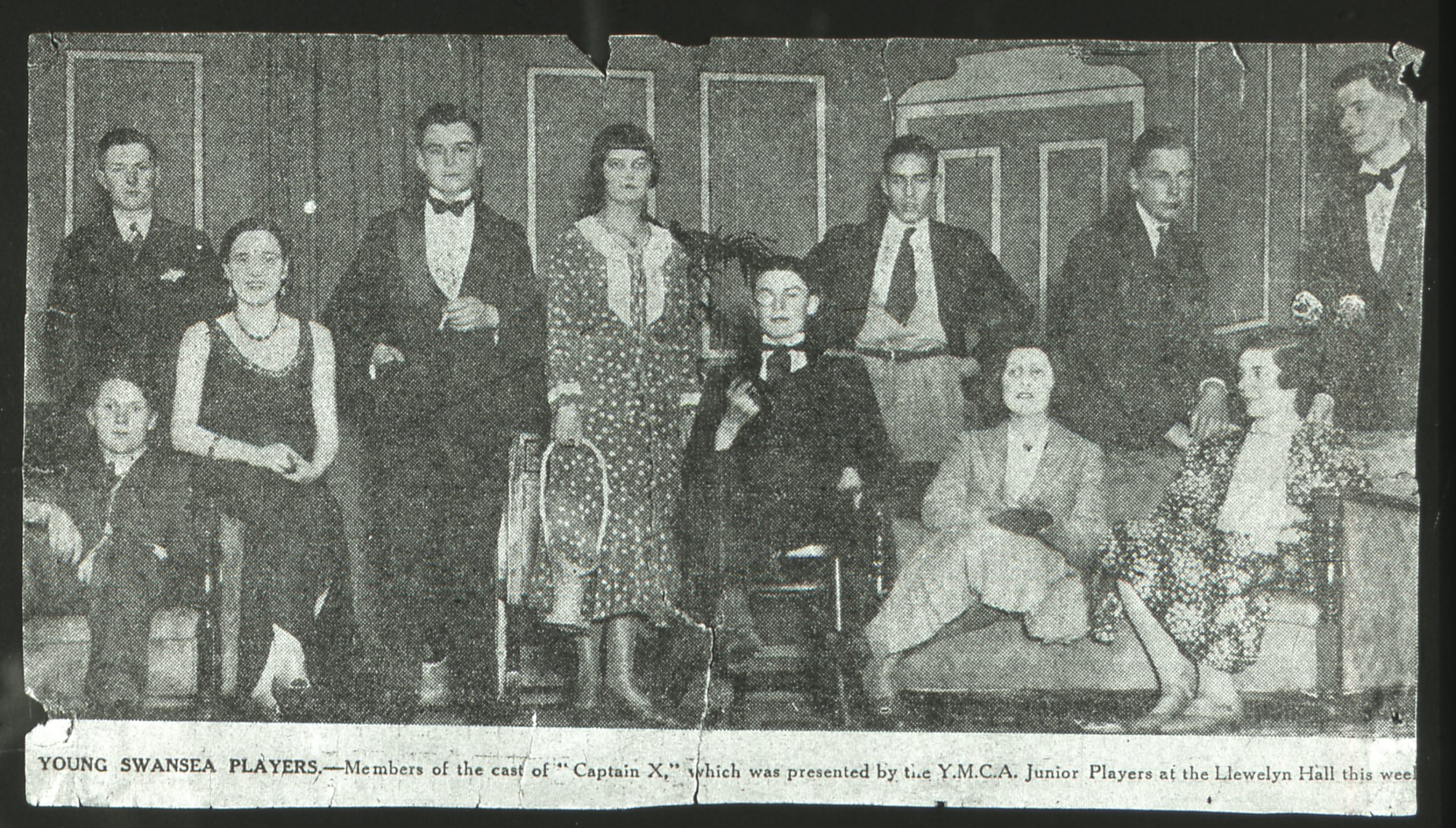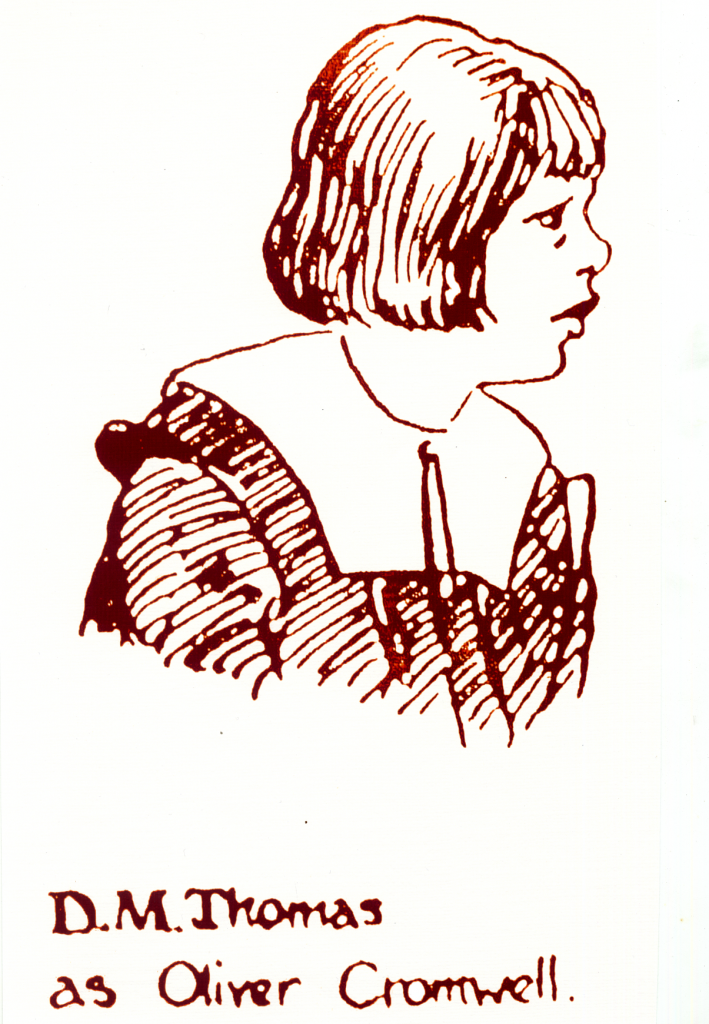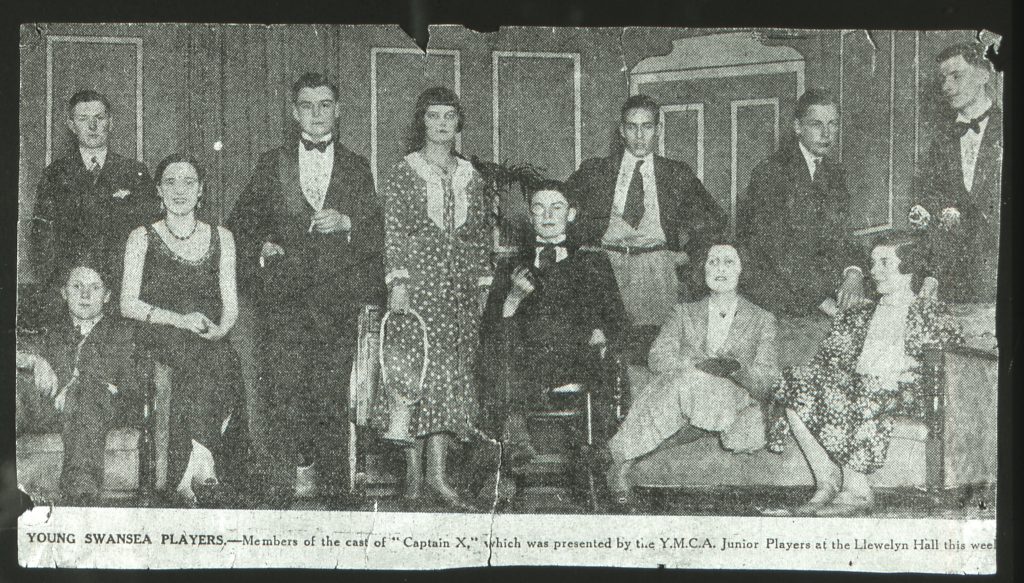Dylan Thomas – Live at the YMCA Swansea

Introduction
Llewelyn Hall is the name of the theatre within the YMCA Swansea building on the Kingsway. It is the only surviving venue in Swansea where Dylan Thomas performed.
While various books and articles have written about Dylan Thomas as an actor, none of the previous research has looked at the archive material held at YMCA Swansea. The Dylan Thomas Centre and the YMCA have worked in partnership to explore this fascinating archive. This exhibition and its supporting material draws on the information found there to reveal the story of Dylan’s appearances in school productions, his performances as a member of the YMCA youth club and then a member of YMCA Swansea, and finally in plays staged under the auspices of the Swansea Little Theatre Company.

YMCA Swansea in the late 1920s
In 1928 YMCA Swansea celebrated its 60th anniversary. By now the YMCA had occupied the current building on the Kingsway for fifteen years.
The 1929 Swansea Trade Directory provides a flavour of the activities including gymnasium classes for men, women and children, a music society, table tennis, lectures, debates and billiards. A number of sports clubs were also attached, meeting on Saturdays, which included three football teams.
A number of other organisations and outside agencies also met in the building including a theatrical society. The arrangement appeared to be that the society would rehearse and put on performances in the Llewelyn Hall, with profits from shows donated to the YMCA.
The AGM held on the16th December 1931 records membership at 116 full members, 215 associate members, 90 junior members and 280 boys. YMCA Swansea was running a youth club and scout group in the two rooms which is now the fitness centre.
No membership lists exist of the youth club but it is clear Dylan Thomas attended and was one of those 280 boys. It was near his home and he was familiar with the building as he had already performed in the YMCA theatre as a schoolboy. Whether he was a member of the youth club and then become involved with the Junior Players or joined because of the drama group is not yet known.
Dylan Thomas attended Swansea Grammar School (now Bishop Gore) located at the time on Mount Pleasant Hill. He first appeared at the Llewelyn Hall at the age of 14 in the school’s production of Abraham Lincoln in May 1929. Dylan played the part of Edward Stanton. Stanton was the Secretary of War in the Lincoln Administration, during the American Civil War. Stanton also organised the manhunt for the collaborators of Lincoln’s assassin, John Wilkes Booth.
Dylan played the lead role in Oliver Cromwell in February 1930, and in December he played the part of the strike leader, Roberts, in Strife. The latter play was written in 1909 by John Galsworthy. He won the Nobel Prize for Literature in 1932, and is now better known for his novels such as the Forsyth Saga.
Ethel Ross, friend of Dylan and author of Dylan Thomas and the Amateur Theatre, mentions the fact that the plays were put on in the Llewelyn Hall but notes that there was problem with the venue:
‘There was a considerable disadvantages, for tense scenes were apt to be punctuated by rhythmic thuds as youths in the gymnasium above worked off their high spirits.’
In reality, it was much more than a case of ‘high spirits’. YMCA Swansea had won the British Gymnastics Championship in 1929 and would retain that title for the next three years.
While still at school, Dylan wrote two sketches, ‘Desert Idyll’ and ‘Mussolini at Breakfast’. The former was published in Swansea Grammar School Magazine in December 1929, and it’s not yet established whether this was performed at the YMCA. ‘Mussolini at Breakfast’ was given to Ethel Ross to be put on by the Little Theatre Co, but she confirms that it was never staged:
‘It has in retrospect an underlying truth and would still be quite good in revue had not fascism ceased to be a subject for humour.’
YMCA Junior Players
Pinpointing the exact start of the YMCA Junior Players is difficult. The YMCA newsletter for April 1929 states:
‘Following mock trials in December (1928) two plays have been selected: The Ghost of Jerry Bundler and The Elusive Lydia.’
The General Secretary reported to the Management Committee the formation of a dramatic club on the 6th of January 1930 and a budget of £30 was allocated for stage and scenery. However whether the above was for the YMCA Junior players or another internal dramatic club is unclear.
The newsletter for March 1930 records a successful production of Seven Keys to Baldplate by the Junior Players. We do not know if Dylan Thomas was involved or not. However, Ethel Ross, in Dylan Thomas and the Amateur Theatre, states that Dylan was involved in another production:
‘As a member of the YMCA Junior Department he played a young sailor in The Monkey’s Paw. The Chairman at the performance Mr. T. B. S. Coats wrote:
‘I remember clearly the extraordinary strength of Dylan’s acting as a seaman. The genius of it all comes back vividly to me.’‘
However, there is no mention of this production in the YMCA Swansea archive.
The first definite production involving Dylan is recorded in the newsletter for October 1930 and in the minutes on the 31st January 1931 stating that a production of the Man at Six was underway to be performed in February. This we know was the YMCA Junior Players and Dylan Thomas performed in it.
The minutes of the 23rd February record a successful performance of the Man at Six and the minutes on the 23rd March mentions that Captain X is in production for April by the Junior Players. The minutes of 23rd February also record that there was little possibility of the theatrical society staging a production.
It is possible that during this period following the successful production of the Man at Six by the Junior Players and the apparent failure of the theatrical society, that discussions were held around the formation of an internal YMCA theatrical society by taking it out of the umbrella of the youth section and dropping the ‘Junior’ to form the YMCA Players. As a YMCA agency, participation would require membership. This is further evidenced by a reference in the May newsletter quoting the Daily Post review of Captain X.
‘As the critic of the Daily Post wrote, Captain X is not an easy play to run. One wonders whether the author appreciated some of the difficulties he created, especially for amateur bodies when he wove his scheme…. Good fortune and most certainly presence of mind were factors in the success of `Captain X’ in the first act. So creditably did they carry the play that the audience were not aware of the disasters that almost occurred.’
The newsletter then goes onto state:
‘”Junior” might be dropped for the title, but the “Players” hope to play on.’
In the same month as Captain X was staged, Dylan Thomas applied for Associate membership. The minutes of the Membership and Religious Work Committee records his name and address and approval of membership on the 27th April 1931.
The minutes of the Recreation and Programme Committee held on the 1st June mentions:
‘Junior Players’ successful presentation of Captain X on 28th April at which 200 people attended.’
The same minutes state under ‘theatrical society’ that ‘nothing further had been heard in regard to the society. It was agreed that the secretary write to all of the membership pointing out their obligations in this matter.’
Minutes for the Recreation and Programme Committee held on the 31st August 1931 under a heading YMCA Players states.
‘An application was received form a body of members for permission to rehearse for and give dramatic productions under the style of YMCA Players and permission to hold a social until 12.’
The application was agreed.
One of the above members mentioned was Henry Dickens. He appeared with Dylan Thomas in a few productions. A number of sources have stated that Henry Dickens was the grandson of Charles Dickens. Our research indicates that he was in fact a second cousin of Charles Dickens.

The YMCA Players
Dylan appeared as Edward Laverick in The Fourth Wall in December 1931 for the YMCA Players.
An undated newspaper cutting also definitely confirms that Dylan also was the producer for the performance.
Dylan was also clearly active in organising the socials and fundraisers for the YMCA Players. He is a cast member playing Sergeant Brewster in Waterloo which is staged before a fundraising dance. Whether this is a full production is unclear. The undated newspaper cutting does not give an indication but there is nothing in the minutes which would suggest a full production.
A few other socials/fundraisers also involved Dylan featuring in humorous sketches as reported in undated newspaper cuttings. One states the name of the sketch as Men Playing Cards As Women Do.
It has also been suggested that he appeared as a poet in Capgar but there are no references to any performance in the YMCA Swansea archive.
There’s some interesting material in a scrapbook held in University of Birmingham, Cadbury Archive and Library Special Collections, file reference YMCA ACC 70/1. It contains various tickets, posters, press cutting and photographs over a period of 1931 to 1936.
The scrapbook begins with photographs and press cuttings related to a production of The Fourth Wall. A photograph of the cast includes Dylan Thomas along with a press cutting of him on stage at Llewelyn Hall. The production took place at the YMCA on December 9th and 10th, 1931.
Various other productions are included in date order. The scrapbook does not include any further productions with Dylan Thomas and therefore it is likely that The Fourth Wall was the only full production featuring Dylan Thomas with the YMCA Players.
The next production was Lord Babs. There is no evidence that that Dylan Thomas was in the production. However a minute from the Recreation and Programme Subcommittee from the 29th February 1932 may give a clue as to his absence. It reads:
‘Permission was applied to produce Lord Babs and also in regard to producing a micawber review. As there appeared to be differences of opinion amongst the players to the latter it was agreed the matter be left with the secretary. Permission to produce Lord Babs was given.’ The word ‘micawber’ above has a correction in pencil which on close examination amends it to Macabre Review.
It is possible that it was Dylan who was proposing a Macabre Review. Dylan had an interest in the gothic, and this is demonstrated in some of the stories he was writing in the 1930s as well as themes in some of his early poems.
Little Theatre
Later in 1931 Dylan joined his sister Nancy at the Swansea Little Theatre Company based at Southend, Mumbles. The Little Theatre also performed fairly regularly at the Llewelyn Hall, and Dylan starred in the April 1934 production of Hay Fever.
The YMCA Players continued for a long period with considerable success. It is possible that Dylan was only involved in one full production but it was a notable one, being the first under the YMCA Players and a play he also produced.
Although Dylan was now with the Little Theatre, it appears he continued to visit the YMCA Swansea on a regular basis to play billiards. Ethel Ross, in Dylan Thomas and the Amateur Theatre, notes;
‘His work as a reporter did not really suit him. He was bored by routine visits to the police station and hospital and writing up petty local functions. In fact he spend much of his time playing billiards at the YMCA.’
Dylan has an interesting connection with the billiard balls on display in our Exhibition. Belonging to Llew T Price of 5 Bryn Y Mor Road, a minute for the Red Triangle Club in 1933 states that Price had presented to them the billiard balls used in a prestigious exhibition match held at the YMCA in early 1932.
The headline participant in the exhibition match was the Australian Walter Lindrum, the greatest billiard player of his age. The YMCA minute book entry on 29 February 1932 states that the programme and recreation committee wanted to pass on their congratulations to all responsible for making Lindrum’s visit a success. As Dylan was a fan of billiards, it’s possible he was at the exhibition match.
Walter Lindrum made a world record break of 4,137 later in 1932, and went on to become World Professional Billiards Champion from 1933 until his retirement in 1950. The billiard room is now the dance studios on the first floor at the front of the building.
Dylan’s formative acting experiences were vital in shaping his famed talents for performing his work on stage in the UK and abroad, and reading his own scripts and those of others for the radio. The first full stage performance of Under Milk Wood, starring Dylan, took place at the Young Men’s and Young Women’s Hebrew Association, New York, over twenty years after he first appeared on stage at the YMCA.

Dylan Thomas – Live at the YMCA
The exhibition will run at The Dylan Thomas Centre between 8 February and 30 April.
Research and text:
Katie Bowman
Carys Evans
Jo Furber
Phil Treseder
Exhibition Design:
Rebecca Davies
Objects and Loans displayed with kind permission of:
YMCA Swansea
West Glamorgan Archive Service
Dylan Thomas Centre
Swansea Museum
Further information on the history of YMCA Swansea can be found at:
http://www.swanseamuseum.co.uk/?s=YMCA
This post is also available in: Welsh


